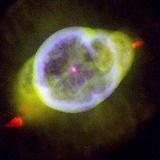
NGC 3242
Encyclopedia
NGC 3242 is a planetary nebula
located in the constellation
Hydra
.
William Herschel
discovered the nebula on February 7, 1785, and cataloged it as H IV.27. John Herschel
observed it from the Cape of Good Hope
, South Africa
, in the 1830s, and numbered it as h 3248, and included it in the 1864 General Catalogue as GC 2102; this became NGC 3242 in J. L. E. Dreyer's New General Catalogue
of 1888.
This planetary nebula is most frequently called the Ghost of Jupiter, or Jupiter's Ghost, but it is also sometimes referred to as the Eye Nebula. It can easily be observed with amateur telescopes, and appears bluish-green to most observers. Larger telescopes can distinguish the outer halo as well.
Planetary nebula
A planetary nebula is an emission nebula consisting of an expanding glowing shell of ionized gas ejected during the asymptotic giant branch phase of certain types of stars late in their life...
located in the constellation
Constellation
In modern astronomy, a constellation is an internationally defined area of the celestial sphere. These areas are grouped around asterisms, patterns formed by prominent stars within apparent proximity to one another on Earth's night sky....
Hydra
Hydra (constellation)
Hydra is the largest of the 88 modern constellations, measuring 1303 square degrees. It has a long history, having been included among the 48 constellations listed by the 2nd century astronomer Ptolemy. It is commonly represented as a water snake...
.
William Herschel
William Herschel
Sir Frederick William Herschel, KH, FRS, German: Friedrich Wilhelm Herschel was a German-born British astronomer, technical expert, and composer. Born in Hanover, Wilhelm first followed his father into the Military Band of Hanover, but emigrated to Britain at age 19...
discovered the nebula on February 7, 1785, and cataloged it as H IV.27. John Herschel
John Herschel
Sir John Frederick William Herschel, 1st Baronet KH, FRS ,was an English mathematician, astronomer, chemist, and experimental photographer/inventor, who in some years also did valuable botanical work...
observed it from the Cape of Good Hope
Cape of Good Hope
The Cape of Good Hope is a rocky headland on the Atlantic coast of the Cape Peninsula, South Africa.There is a misconception that the Cape of Good Hope is the southern tip of Africa, because it was once believed to be the dividing point between the Atlantic and Indian Oceans. In fact, the...
, South Africa
South Africa
The Republic of South Africa is a country in southern Africa. Located at the southern tip of Africa, it is divided into nine provinces, with of coastline on the Atlantic and Indian oceans...
, in the 1830s, and numbered it as h 3248, and included it in the 1864 General Catalogue as GC 2102; this became NGC 3242 in J. L. E. Dreyer's New General Catalogue
New General Catalogue
The New General Catalogue of Nebulae and Clusters of Stars is a well-known catalogue of deep sky objects in astronomy. It contains 7,840 objects, known as the NGC objects...
of 1888.
This planetary nebula is most frequently called the Ghost of Jupiter, or Jupiter's Ghost, but it is also sometimes referred to as the Eye Nebula. It can easily be observed with amateur telescopes, and appears bluish-green to most observers. Larger telescopes can distinguish the outer halo as well.
External links
- The Hubble European Space Agency Information Centre – Hubble picture and information on NGC 3242]

